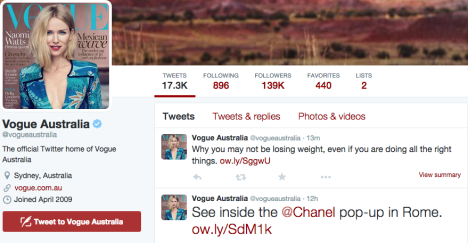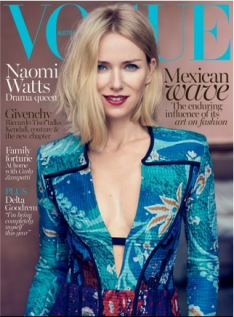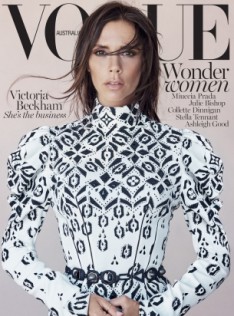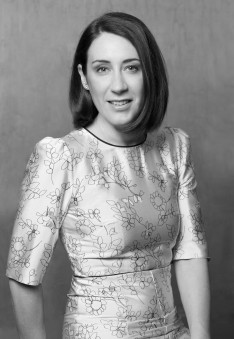Vogue’s Edwina McCann: Unlike some of our competitors, we’re still investing in content
With events like this month’s Vogue Fashion’s Night Out, digital editions, a website and brand events, Vogue is more of a brand than a magazine, editor-in-chief Edwina McCann tells Mumbrella’s Miranda Ward.
What are the challenges in editing a title like Vogue?
For a start the job has changed quite dramatically in the last three years and definitely five years. The challenge nowadays is really running a business with multiple and constantly changing revenue streams.
In terms of the editing part of what I do, it’s a lot less then it was when I first became an editor six and a half years ago. That would be the challenge at the moment, it would be time management which has more to do with driving the business then editing a magazine.
What are the revenue streams for a brand like Vogue?
We very much consider it Vogue the brand. At the centre of that is the magazine that we produce and the digital editions that we produce as part of the magazine. Clearly that has two revenue streams – circulation and advertising revenue.
Then our sales force, marketing and editorial work over the brand as a whole. Other parts of the brand is obviously Vogue.com.au which is a fashion, beauty and celebrity news site and that is a very substantial part of our business with its own revenue stream.
Then we have developed our experiential side of the business which has had quite dramatic growth over the past three years, which includes its centrepiece Vogue Fashion’s Night Out which we expanded to Melbourne this year, in Sydney it’s in its sixth year. We also host a lot of other specialist and bespoke events. We work a lot with the Chinese expat market and our luxury events hosting very bespoke events in Sydney and Melbourne.
And then other events, for example we hosted an event with Samsung in which we showed the Dion Lee runway show from New York Fashion Week which we had redone and tailored it and it has gone up on Vogue.com.au. It was behind-the-scenes interviews, so it was like sitting in the front row with Vogue Australia. Samsung worked with us to look at the Australian designers showing on the international runways and finding ways to bring that experience to our online audience.
 How important are events like Vogue Fashion’s Night Out in terms of engagement with readers and advertisers?
How important are events like Vogue Fashion’s Night Out in terms of engagement with readers and advertisers?
Enormously now. Our sales force; we don’t even call them sales force – now they’re marketing solutions. They’re working with brands to work across all our platforms, of which a very important one is experiential.
We are engaging with the customer when they buy the magazine and sit down and read it, and then clearly we’re hoping they’re following us on our social media channels and visiting our website daily.
And then on top of that I think it’s incredibly important we have these real life experiences where people can come and experience the Vogue brand for a night. Fashion’s Night Out is an opportunity where they can come and shop like a VIP Vogue reader. The retailers, David Jones, really go to town and put on runway shows and there’s champagne and canapes. It’s the type of event a Vogue staffer would be invited to all the time, but staged for a Vogue reader and the public.
It’s become a very important part of the greater Vogue catchment and become more important as our social media reach has grown.
Clearly the numbers on social media is much bigger than our traditional magazine audience so therefore the types of experiences we can offer to this broader audience needs to evolve and be far reaching.
Vogue Fashion’s Night Out has shopping at all price points for all budgets, that again gives us an opportunity – Vogue is still going to give you the best experience, no matter what your budget is, if you come to one of our events.
 Is social media one of the biggest changes in the publishing industry?
Is social media one of the biggest changes in the publishing industry?
It’s a combination of factors. In terms of Vogue’s evolution as a brand, the past three years the change and the upskilling on our sales commercial side, even on our marketing side, they’ve had to become digital marketing experts and incredible event managers as well at the same time. The upskilling in every area of our business has been dramatically fast.
Obviously social media is just another add-on, another platform you need to understand and you need to understand how to manage your brand on it.
I don’t think brands are exactly where they need to be. I think you’ll see a lot more collaboration in this area long term. Because a lot of social media platforms are really distribution platforms. Traditionally we had a newsagent who was a distributor of our magazine and now you may have Instagram who is effectively distributing your social media content.
Looking into the future for the industry, is there going to be a greater focus on unlocking those opportunities on social media?
For a long time we have thought one thing replaces another. That’s not what’s happening.
 We’ve always been in this very collaborative relationship with celebrities and models from an editorial point of view. So what we’ve had is quite a unique access to extraordinary people who appreciate the quality of the fashion photography and storytelling we bring to the table.
We’ve always been in this very collaborative relationship with celebrities and models from an editorial point of view. So what we’ve had is quite a unique access to extraordinary people who appreciate the quality of the fashion photography and storytelling we bring to the table.
What that now allows is an opportunity for us to create content on all of our platforms, the access gives us the opportunity to create more content on more platforms. If I didn’t have the magazine and didn’t have that cover to offer in the first place I wouldn’t have that access.
The appetite for content can be cyclical and it’s very important to adapt within your brand prism, it’s really important to look at micro-trends that are impacting your demographic and your audience.
There’s always a solution within the brand and that’s the future to continue to be able to see the opportunities commercially and editorially in terms of customers. The long term vision for a brand like Vogue is deeper relationships with audience who we can identify as the super users, buying your magazine, coming regularly to the website, following us on social media and coming to our events and being able to offer those consumers more and more.
You took on the editor-in-chief role back in 2012 – taking over the job from Kirstie Clements who had held it for 13 years – how did you go about putting your stamp on the title?
In the beginning, I had worked for Vogue for six or seven years in my early twenties so I had a clear vision of what I wanted Vogue Australia to be and stand for and I did think we needed to change our work practices.
It was an exciting period where with the brand we had the opportunities were boundless and I hope that was the attitude I brought to the job at that time.
It definitely required a retraining, a re-calibration of our workforce and we’ve all been on that journey together.
It’s certainly changed the role of an editor quite dramatically. I haven’t just asked it of other people, I’ve had to learn to think differently, learn to use my time better and more effectively. Everything’s changed.
My hope at the time I was going to create a sustainable future for the beautiful brand of Vogue on all its platforms. I was passionate about the brand and everyone was talking about print being dead and I couldn’t bear the idea of Vogue not being there.
It’s a brand worth protecting and the way to protect it was to grow it and change it.
The most recent figures from the Audit Bureau of Circulation saw Vogue’s circulation climb by 2.6 per cent from a circulation of 50,325 a month to 51,657, how important are circulation numbers?
 They’re still important but we look at an overall brand reach number. We’re very focused on the overall reach of the brand , however, we want print to remain a sustainable proposition and we want to continue our loyal subscribers.
They’re still important but we look at an overall brand reach number. We’re very focused on the overall reach of the brand , however, we want print to remain a sustainable proposition and we want to continue our loyal subscribers.
What is unique about the Vogue brand in the past year, with the support of my CEO and my publisher, we have reinvested into editorial print content. We’re creating a lot more content around that that is also digital and social content but we are actually spending more than we were on a year prior, on the shoots.
When it came to shooting Victoria Beckham, I felt very passionately, and she did very well for us in terms of sales. She’d done a cover for me as editor before, I wanted to do another one and she wanted to work with Patrick Demarchelier who is one the biggest photographers in the world, he is not cheap!
It is paying off but it has required the company to say content is worth investing in, and they are investing in content. When I look around at my competitors I don’t know how many would be able to say that.
Edwina McCann is presenting a case-study on ‘how to build a brand not a masthead’ at next month’s Publish Conference. Click on the banner below for information on the program and how to buy tickets.





 Linkedin
Linkedin
Edwina is incredibly driven to quality, responsible and loyal to the magazine audience.
As the one who has hired (and unfortunately fired) several of these editors, I can honestly say, Edwina is the best editor-in-chief VOGUE Australia has experienced since the magazine was launched in this country. Keep going Edwina. This country need more talents like you.
User ID not verified.